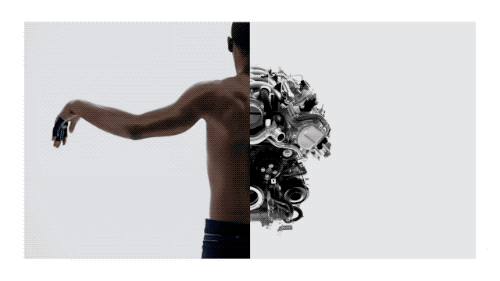Man versus Machine: The Danger of Spectacularising Black Bodies
During the 2017 Super Bowl, Lexus released a commercial for their LC 500 featuring the performance of street dancer Lil Buck. The spot opens with several quick shots: the hooded top of Lil Buck's head; then, the front of the car with headlights beginning to glow; next, a close-up of Lil Buck's face as he opens his eyes. The glow of the headlights still lingers in the viewer's gaze as the whites of Lil Buck's eyes appear, beginning the direct one-to-one comparison between the dancer's body parts and pieces of the machine. During the one-minute extended version of the commercial, Lil Buck is shown on a split screen with the car nine times.
Dance scholars Sherrill Dodds and Colleen Dunagan explore the use of dance on the popular screen and more specifically in commercials, emphasising the relationship between dance and the spectacular. However, neither Dodds nor Dunagan focuses their interrogation on the way that spectacle, and with it the creation of a "superbody," is particularly problematic for black bodies. Dunagan's 2018 Consuming Dance: Choreography and Advertising focuses on the unique intertextual screen space of advertisement and the major role that dance plays within advertising today. Dunagan draws on Guy Debord's work on spectacle, arguing that "commercials employ dance as a vehicle for the amplification of consumption-as-spectacle."1 Through numerous examples, Dunagan demonstrates a variety of ways in which spectacle is employed to generate nostalgia and bring the viewer into a sense of connection with the dancers and, through the dancers, the product at hand. However, rather than connect us to Lil Buck, the Lexus commercial splits and segments his body in such a way that it creates further distance between the viewer's whole body and Lil Buck's fragmented one. Dodds depiction of "superbodies," described in the concluding chapter of the Oxford Handbook of Dance and the Popular Screen as bodies that "exceed the physical capacities of the live human body,"2 lines up much more closely with the way Lil Buck is presented within the commercial. This leads me to ask, when is technological embodiment a possibly liberatory representative frame, and when is it part of an updating of the commodification of black bodies?
Lil Buck's construction as machine-like or as a "superbody" falls within a historical trajectory of commodifying blackness, setting up black people as outside the category of human. In Habeas Viscus, Alexander Weheliye argues that "race, racialization, and racial identities [are] ongoing sets of political relations that require, through constant perpetuation via . . . technologies, sciences, economies . . . the barring of nonwhite subjects from the category of the human as it is performed in the modern west."3 Historians Joel Dinerstein and Bruce Sinclair support Weheliye's claim as it relates to technology, arguing that white people have worked to position themselves as the keepers of technology, denying other groups potential and capability.4 This becomes apparent in the Lexus commercial, in which the dancer's body is equated with the technology rather than as a "keeper" of technology. For example, many commercials feature a celebrity driving a vehicle, often with a backdrop of city streets or winding country roads. In these cases, advertisements seem to suggest that we too can be like the celebrity handling the car if we get behind the wheel of such a vehicle. In contrast, while Lil Buck does "pour" himself into the car and place his hands on the steering wheel midway through the commercial, he is then shown once again dancing outside the vehicle, moving alongside the car as it peels out of the white box into a larger industrial looking space. It's not about Lil Buck's ability to drive the car, but a suggestion to drive the Lexus LC 500, which moves as nimbly as Lil Buck, that is being presented here.
Although "super" is primarily framed as a positive attribute, this presentation of Lil Buck extends the construction of black people as outside the category of human. In fact, in three of the commercial's shots, it moves beyond comparison with a machine to show a portion of Lil Buck's body melding to the engine, making him part of the machine. Each takes place against a black backdrop, with low light so that the distinction between human and machine is minimised. In the first of these shots, Lil Buck's head appears behind the engine, arms wrapping around it. In the second shot he is in front of the engine, head down facing the engine and he is shifting his shoulder, again arms hugging the machine. The final shot takes place as part of a montage of the car starting. Lil Buck's finger presses the start button, the covered engine inside the car is shown accompanied by the sound of an engine revving, a close-up of the tachometer's glowing display, then a whooshing sound as Lil Buck's elbows rise to either side of the engine. In this final shot his head is not visible; Lil Buck is becoming more machine than man in this shot where the engine appears to have become his torso. Only his arms are visible, and they seem to be working in harmony with his new metal centre.
Dehumanising black bodies can be deadly. In 2014, Officer Darren Wilson of Ferguson, Missouri claimed Michael Brown's superhuman strength required he shoot at Brown to defend himself. He testified, "And when I grabbed him, the only way I can describe it is I felt like a 5-year-old holding onto Hulk Hogan."5 Journalist Sabrina Siddiqui notes that Wilson was nearly the same size as Brown, despite Wilson's repeated statements about how overwhelmed and outsized he felt in the situation. When black people are portrayed as machines or machine-like by media, real people pay the price.

